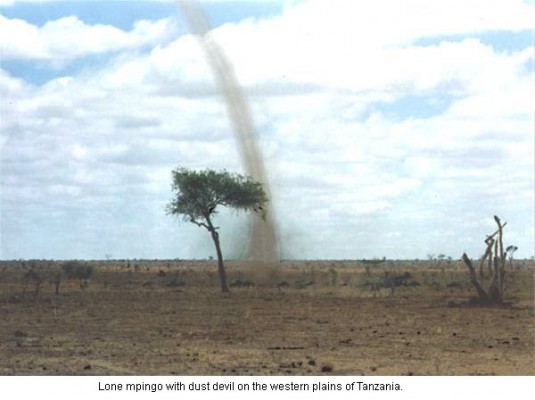Common Name(s): African Blackwood, Mpingo (Swahili)
Scientific Name: Dalbergia melanoxylon
Distribution: Dry savanna regions of central and southern Africa
Tree Size: 20-30 ft (6-9 m) tall, 2-3 ft (.6-1.0 m) trunk diameter
Average Dried Weight: 82 lbs/ft3 (1,310 kg/m3)
Basic Specific Gravity: 1.08
Hardness: 4,730 lbf (21,060 N)*
*Estimated hardness based on specific gravity
Rupture Strength: 31,000 lbf/in2 (213,790 kPa)
Elastic Strength: 2,980,000 lbf/in2 (20,550 MPa)
Crushing Strength: 10,470 lbf/in2 (72.2 MPa)
Shrinkage: Radial: 2.5%, Tangential: 4.5%, Volumetric: 7.6%, T/R Ratio: 1.8
Color/Appearance: Often completely black, with little or no discernible grain. Occasionally slightly lighter, with a dark brown or purplish hue. The pale yellow sapwood is usually very thin, and is clearly demarcated from the darker heartwood.
Grain/Pore: African Blackwood has a fine, even texture, with small pores that should not require filling; the grain is typically straight.
Endgrain: Diffuse-porous; both small and medium sized pores in no specific arrangement; solitary and radial multiples of 2-3; dark brown deposits present; growth rings may be distinct due to marginal parenchyma; rays not visible without lens; parenchyma banded (marginal), apotracheal parenchyma diffuse-in-aggregates, paratracheal parenchyma can also be vasicentric, and aliform (winged).
Durability: Heartwood is rated as very durable in regards to decay resistance, though only moderately resistant to insect attack. The sapwood is commonly attacked by powder-post beetles and other borers.
Workability: Very difficult to work with hand or machine tools, with an extreme blunting effect on cutters. African Blackwood is most often used in turnery, where it is considered to be among the very finest of all turning woods—capable of holding intricate details, and is reported to hold screw threads nearly as well as metal.
Mpingo, the East African Blackwood tree, is used to make clarinets and oboes, and is the medium of choice for local wood carvers. Its dark, lustrous heartwood is one of the most valuable timbers in the world. The tree is under-threat from over-exploitationand could become commercially extinct.
This tree is great for those who do agricultural work as it is known to improve the fertility of the soil as well as the soil’s stability. The Blackwood is a great source of food for various herbivores as well as livestock as these animals will eat its leaves. Despite being a very hardy tree (most of the mature trees are even able to survive a fire), the population of the African Blackwood has been on the decline.
In Swahili, the population of the African Blackwood continues to diminish. The name comes from the color of its heartwood which is a color closely resembling black. The tree is said to grow in areas where most other trees or plants couldn’t, as it prefers infertile and rocky soil. The Mpingo is also very slow growing, taking between 70-200 years to grow to a mature size and many only grow to be able 9 feet. tall. It is the national tree of Tanzania even though the tree can be found in about 26 different African countries, including Ethiopia, Angola, Senegal, and many others.
What’s the cause of threat of extinction?
The extremely dark heartwood of the Blackwood is definitely one of the most widely sought after timbers in the entire world. Some of the highest class instruments, mostly woodwinds, are made of this wood. It is also used to make furniture as well as for carving purposes. Carving this wood has been done since the 1930s, but today it’s extremely hard for the carvers to find enough wood to use, which means many times that the timber is imported. The trees are often harvested for this timber and other seedlings are rarely planted in their place. Even though mature Blackwoods can survive a fire, the seedlings cannot, which greatly slows down regeneration.
The African Blackwood Conservation project is working each day to help regenerate these trees because they are declining in population so rapidly. The group plants new trees each year in hopes that the tree population will be replenished. Seedlings are grown at the Moshi Mpingo Plot and the transported to a place where the tree can mature.
Harvesting and Products
It takes about sixty years to produce a commercially viable specimen (straight trunk, large diameter), and today there is an estimated 3 million trees, with only 20% or 600, 000 of them suitable for harvesting. In the market, the wood can be found in different grades, depending on the use, with Grade A often calling for a hefty sum.
The wood is commonly used for musical instruments as it is strong, moisture absorbent and withstands the carving process. It may also be used for knife handles, boxes, jewellery, furniture, bowls and ornamental objects. It is also used for carving prayer beads, one of the most noble uses that a wood can be put to. In the pictures below, you can see the slightly reddish tint that may appear in different pictures


.jpg)








.jpg)










